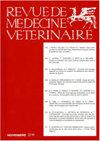Q2 Veterinary
引用次数: 5
摘要
简介:片吸虫病是一种由世界范围内的雌雄同体吸虫肝片吸虫病引起的传染性寄生虫病,可感染草食性动物、杂食性动物,偶尔也可感染人类。目的:了解2011年和2012年夏万卡市屠宰场屠宰的牛中肝片吸虫的感染情况及其相关因素。方法:采用(死后)脏器卫生检查确定感染。统计学分析采用SPSS 11.5软件包,采用Pearson’s χ 2、优势比、95%置信区间、Student’s t检验,p≤0.05。结果:片形吸虫病发生率为24.6%(564/2293)。2012年感染率高于2011年(OR = 3.4;Ci 95% = 2.7-4.1;P < 0.01)。无降雨月份感染率较高(OR = 1.7;Ci 95% = 1.4-2.1;P < 0.01)。2011年屠宰的大多数牛体重< 100公斤(OR = 407.9;Ci 95% = 191.9-867.4;P = 0.000)。在降雨季节,大多数胴体体重≥100 kg (OR = 0.2;Ci 95% = 0.2-0.3;P = 0.000)。结论:我省片形吸虫病感染程度为中等,应考虑为中流行区。2011 - 2012年各区感染呈上升趋势。片形吸虫病与降雨和牛的原产地有关。性别和降雨季节与胴体重有关。雨季胴体重增加。本文章由计算机程序翻译,如有差异,请以英文原文为准。
Fasciola hepatica en bovinos del valle interandino de Aymaraes (Perú): identificación de factores asociados
Introduction: Fascioliasis is an infectious parasitic disease caused by the worldwide hermaphroditic trematode Fasciola hepatica , which affects herbivorous animals, omnivores, and occasionally humans. Objective: To determine the presence of Fasciola hepatica and its associated factors in bovines slaughtered in the municipal slaughterhouse of Chalhuanca during 2011 and 2012. Methods: The infection was determined by (post-mortem) sanitary viscera inspection. For the statistical analysis, SPSS 11.5 package was used through Pearson’s χ 2 , odds ratio, 95% confidence intervals, Student’s t-test, and p ≤ 0.05. Results: The frequency of fascioliasis was 24.6% (564/2293). In 2012, the infection was higher than in 2011 (OR = 3.4; CI 95% = 2.7-4.1; p < 0.01). In months without rainfall, there was a higher infection rate (OR = 1.7; CI 95% = 1.4-2.1; p < 0.01). The majority of bovines slaughtered in 2011 weighed < 100 kg (OR = 407.9; CI 95% = 191.9-867.4; p = 0.000). In rainfall seasons, most of the carcasses weighed ≥100 kg (OR = 0.2; CI 95% = 0.2-0.3; p = 0.000). Conclusions: The fascioliasis infection in the province of Aymaraes is moderate, thus it must be considered as a mesoendemic zone. The infection increased from 2011 to 2012 in all districts. Fascioliasis is associated with rainfall and the place of origin of the cattle. Sex and rainfall season are associated with carcass weight. Carcass weight increased in rainfall seasons.
求助全文
通过发布文献求助,成功后即可免费获取论文全文。
去求助
来源期刊

Revue De Medecine Veterinaire
农林科学-兽医学
CiteScore
1.30
自引率
0.00%
发文量
0
审稿时长
18-36 weeks
期刊介绍:
The Revue de Médecine Vétérinaire publishes four kinds of text:
1) Scientific reviews on subjects related to veterinary and comparative medicine. Suggested length: 10 to 30 typed pages.
2) Original reports on fundamental or applied research. Suggested length: 10 to 15 typed pages.
3) Continuous education articles, that should be easily understandable by non-specialists. Suggested length: 10 to 15 typed pages.
4) Clinical reports. Suggested length: 5 to 15 typed pages.
The publication can be done in French language or English language.
For an article written in English by not english native speakers authors, the manuscript must be subjected by attesting that it was read again by an anglophone scientist or a scientific translator.
The authors must certify that the manuscript was not published or subjected for publication to another review.
The manuscript must be accompanied by a sheet signed by all the joint authors indicating their agreement for the tender of the manuscript.
The publication is free but a financial participation could be required for the photographs color. An estimate will be sent to collect the agreement of the authors.
 求助内容:
求助内容: 应助结果提醒方式:
应助结果提醒方式:


